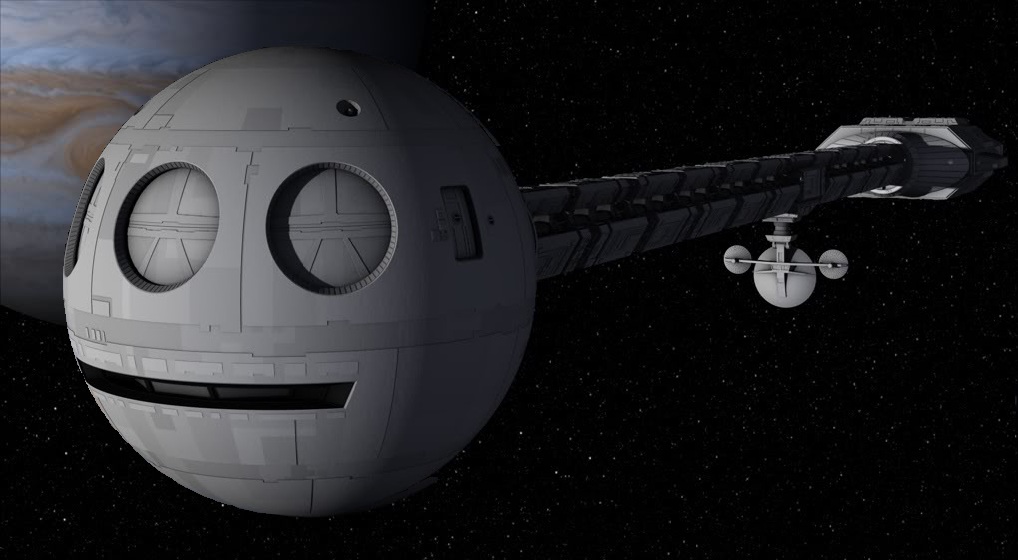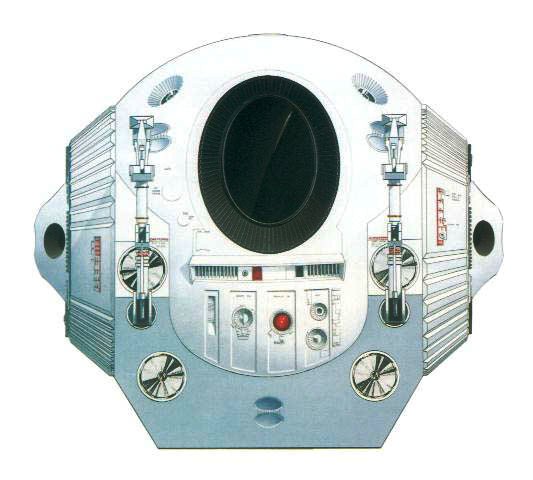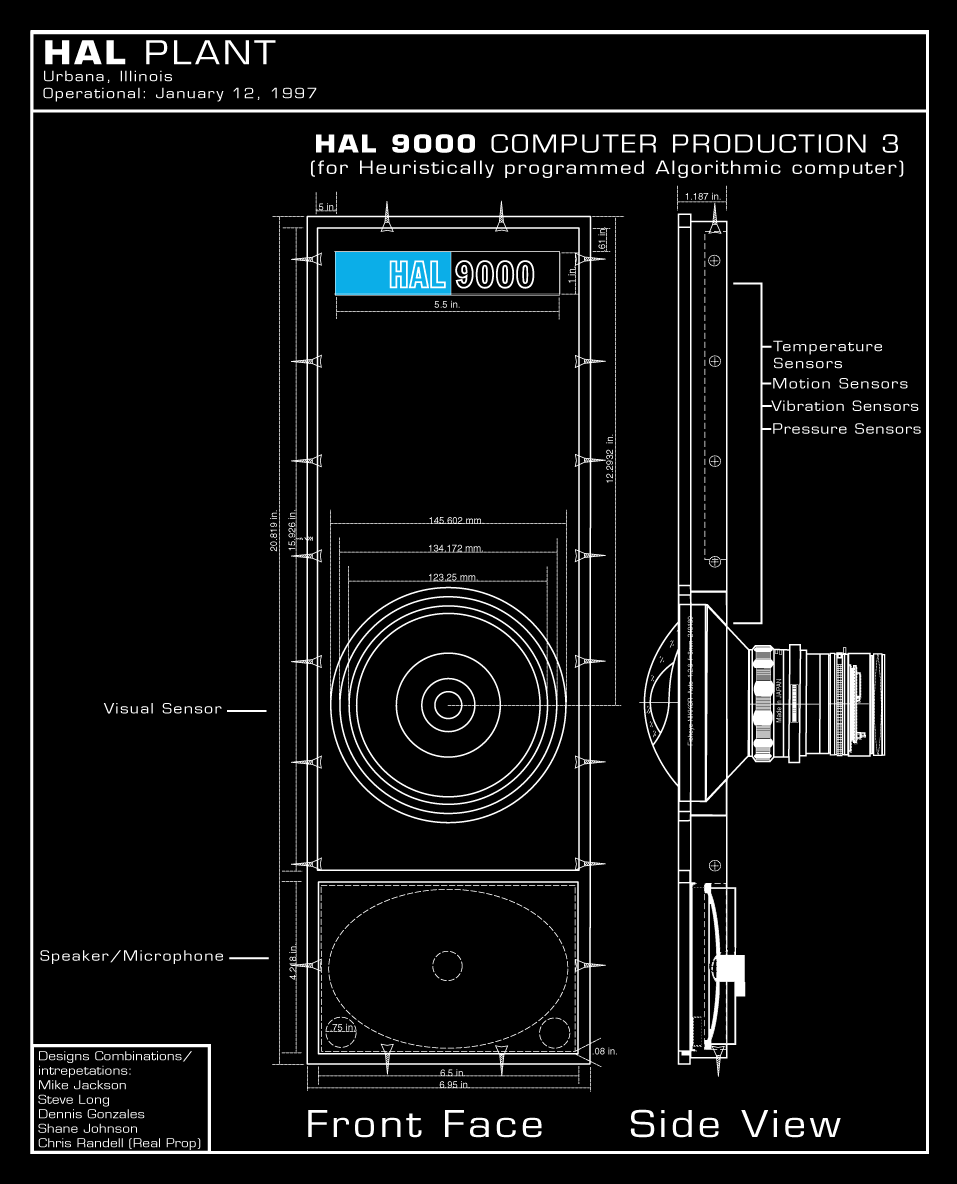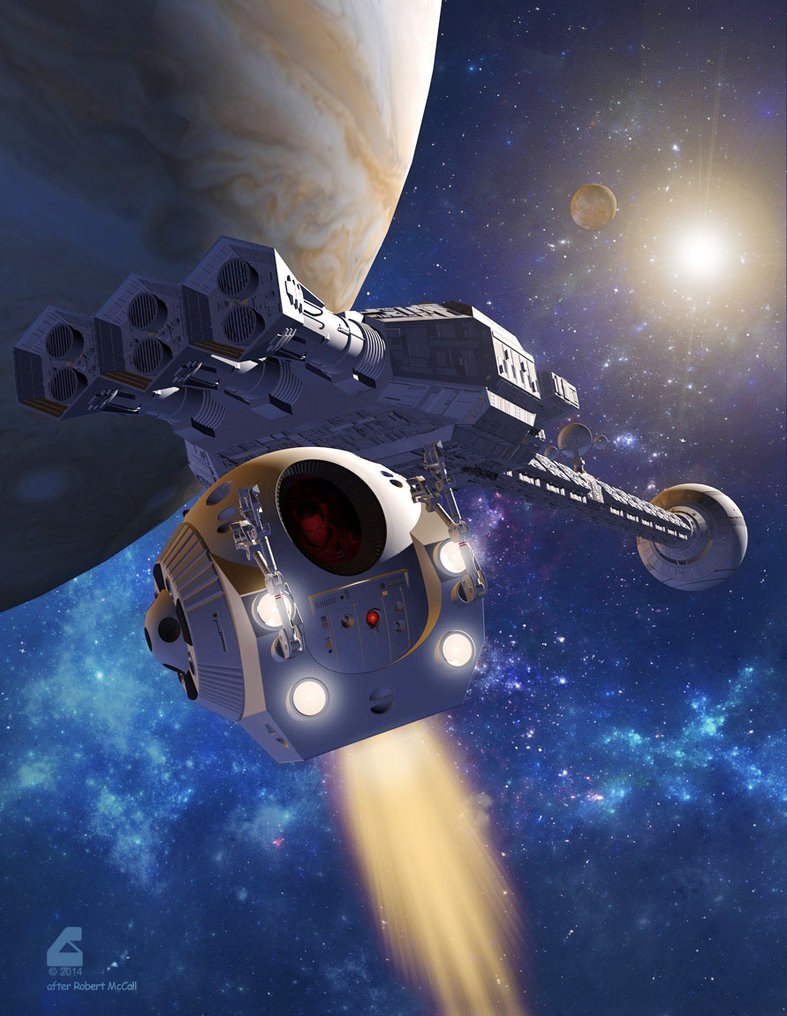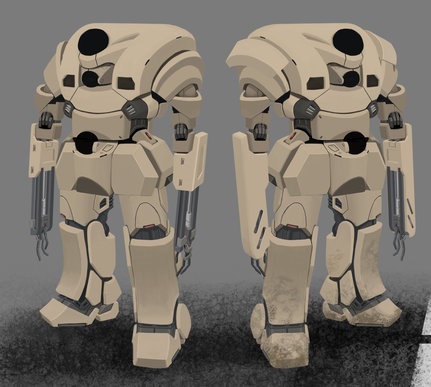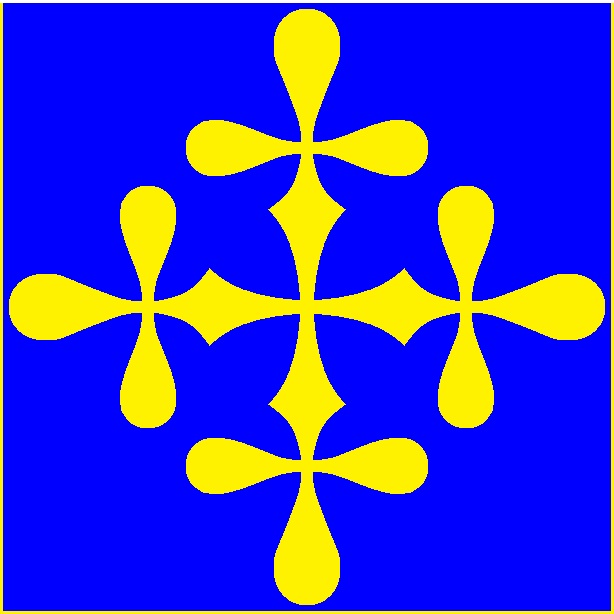 | Executive Transport. |  | |||||||||||||||||
|---|---|---|---|---|---|---|---|---|---|---|---|---|---|---|---|---|---|---|---|
The Chairman-Class Executive Transport was first conceived as transport for the Chairman of the United Galaxies Council. Well armored, well armed, and escorted by a battle fleet of it's own, the Chairman Hayes-Hunter was
Used extensively throughout the UGC as the homes and offices of executives for thousands of worlds, corporations, and etc, these vessels have risen to the collective challenges facing them; From pirates to rebellions to invasions, these little planets have served well whatever the owner requests. The vessels are highly adaptable, and extra radar/radio antennas, thrusters, and weapons systems can be added. The one shown below is a base-line model, with 02 retractable pylon antennas and 06 thrusters. Chairman-Class's sister Class, the ADMIRALITY-Class Cutter, is in service throughout the Patrol, as well as several thousand in the hands of security services, mercenaries, pirates (at least 60,000 are used by Fehran Malcontents, and at least that many more are in the hands of T'sentraedi Malcontents), and even as luxury vessels. Each new UGC Chairman is issued one of these vessels, named for the Chairman to whom it is commissioned, their to keep for the rest of their lives (for example, the second of the fleet was the Chairman Morhanna.) Upon their death, their vessel is de- commissioned and transferred to President's Point Anchorage, a Lagrange 03 Point between Jupiter and Io, where the gravitational effects of Io keep the vessels moving. It is then re-designated a Presidential Library. (Example; The Chairman Morhanna Presidential Library.) The only noteworthy exception is the Chairman Hayes-Hunter, which served as a prototype ship (to test and develop the basics of the design) for 50 years, then was decommissioned and became the The Chairman Hayes-Hunter Presidential Library. A few Chairmen have also asked that their ship become a mausoleum, and to this end the Presidential Suite is closed off to the public to serve as their crypt. Executive Suite. The Executive Suite is the Chairman's person residence. Included in the Executive Suite is everything an office building would need, in addition of an apartment building suitable to support the Chairman's staff and a hotel to host various UGC legislators and staff who may be visiting the Chairman overnight. These spaces on Q-Ships are typically stripped out to make space for additional defensive equipment. Executive Accommodations. The Chaiman's personal quarters; Included is the Chairman's personal berthing, galley, the Executive Office, and literally anything else they might need. Upon their death, this space comes available as the owner's mausoleum. Executive Office. The Chaman's personal office. Upon their death, the Executive Office becomes the office of their library curator. Crew Spaces. The ship's crew spaces are generally off limits to the Executive staff except under escort by a crew member. This is a safety issue- The executive staff have no real business there, and can both damage and be injured by the various equipment. Each Chairman is required to take a tour of the ship before accepting delivery, but that is the most they will generally spend in these spaces. Security personnel will routinely make a round of the crew spaces, but they make a point of it not to touch anything nor interfere with crewmembers unless absolutely necessary. Alpha Echo Three Five Comms Array. The Alpha Echo Three Five Comms Array (generally referred to as the "AE thirty-five") is the massive communication array on the ventral side of the main hull of hulls built for high ranking members of the UGC. This array is always points towards President's Point unless specifically directed otherwise. Another AE35 at Presidents Point and a few other sites around the empire can be linked to the array; Using a combination of computer generated encryption and hypercomms (a system of radio that uses space fold technology as the transmission carrier) the Chairman can maintain real time communications anywhere at any time. Click here for more info on the AE-35. HAL Systems. Of special note it the Chairman-Class' HAL (Heuristically programmed ALgorithmic computer) control System; HALs are an artificial intelligence that interacts with the crew of a Chairman-Class Executive Transport, usually identified
Originally intended as a platform for massed drone control, the system failed due to technological limitations and legal and moral objections; The systems needed to do this were far too complex (2,000 scientist with at least 20 years experience each, and over a millennia combined tried but failed over the course of almost 100 years), and legal and moral objections developed over the issue of inhuman machines making life-and-death decisions (though not technically illegal, there were legal issues, but the moral objections of "inhuman machines killing civilians because they could not differentiate them from enemy soldiers" carried just enough weight to suspend development). HAL's can make all the necessary decisions to operate the ships, but for the same legal reasons that scuttled the program from militry applications prevent them from operating without a person on the bridge (the Officer Of the Deck/Officer Of the Day, or OOD, at very least, and often a Quartermaster Of The Watch and helmsman; at very least these crewmembers authorize the actions 'recommended' by the HAL system). For more information on the HAL-9000 System, Click HERE. Workpods. The Chairman-Class' unique design required a new breed of pod for the ship; The bow of the ship's round design, while it will mate successfully with most UGC standardized pods, only one or two will fit effectively. To increase the pod load, a new breed of one-man work pod with twin boom arms were developed. Up to 08 of these are carried on each Chairman-Class. See Chairman-Class Workpod. Chairman EVA Suit. Chairman-Class are not 'common shuttles.' The owners of these ships expect a certain degree of comfort. Partially as a result of this, the Chairman-Class design team developed their own class of powered suit for EVA. Click here for more in the suits. Defensive Systems. Space is a big, empty, and very dangerous place, and living creatures make it more so. Even the title of the Chairman's ship doesn't stop natural events, and pirates, assassins, and other threats treat that title as an invitation. Sheilds. The Chairman-Class are factory equipped with medium variable force fields (300 MDC per panel) which can be upgraded at extra cost (to as much as 1,000 per panel). Point Defense Lasers. Generally adequate for asteroids and smaller missiles, 10 turret mounted PDLs are positioned around the ship. These can be controlled by an automated system or manually operated. Heavy Beam Cannons. Two T'sentraedi heavy energy turrets (1 dorsal aft the other ventral forward) give excellent protection against most ships that could skirt through an escort screen. These can not be fired by an automated system, but they can be aimed by them. Fighter Complement. Each Chairman-Class hull that slips her moors for the first time has a hanger bay capable of holding at least 10 Veritechs, plus hull piercings for another 40 parasite fighters. More can be added by extensive modifications (see Q-Ships). Comms. A critical component of a Chairman-Class's defenses is her ability to communicate with friendly ships nearby; To this end, each ship has a comms array almost equal to the REF's Central Comms Array on each BREETIA TUL-Class Ultra-Dimensional Fortresses. This is far more than most owners need, but it is available. FTL Capabilities. The most important defensive ability of a Chairman-Class is her ability to run away from a fight. To this end, a very complex and expensive triple phase FTL Kobolese style system allowing the ships to jump away in as little as 5 minutes. At the buyer's request one or more can be replaced with an alternative (the most common being a Rakatan Hyperspace or Antran Warp Drive). Q-Ships. It is an open secret that some Chairman-Class hulls are sent out with extensive combat oriented modifications posing as civilian ships, mostly by shipping concerns in regions where pirates are known to have operated. On the so-called Q-Ships, as many as 20 T'sentraedi heavy turrets can be mounted in addition to missile batteries and as many as three times the normal fighters, but these additional turrets require more power, meaning amenities have to be removed to make room. Name: Chairman-Class Model Type: Executive Transport Crew: 10,000; Duties ranging from "Stewart," "Engineer," and "Spacer" to Commanding Officer. Passengers: As many as 10,000 more. M.D.C. By Location: | |||||||||||||||||||
| Main Hull- Bridge- External Hatches (about 200)- Internal Hatches (up to 1,000)- | 100,000 10,000 150 each 100 each | Fighter Hanger Doors (5)- Radar/Communications Antenna Arrays (03, 05, or 06)- Thrusters (06, 08, or 10)- 10,000 each | 500 each 1,000 each 10,000 each | ||||||||||||||||
| Speed and Statistical Data: | |||||||||||||||||||
| Spacefold: Optional. FTL: Factor 20. Cruising Speed: Mach 20. In Atmosphere: Mach 05. Clearance: 200 feet. Beam: 500 feet. Length: 2,000 feet. Weight: 20 million tons. | Cargo: 500 tons. Power Systems: Primary: Solar Sails Lifespan: Unlimited, but can not achieve FTL; Used for station keeping in system. Secondary: SARS-2,100 Reflex System Lifespan: 21 years. Tertiary: Emergency Batteries 200,000 Lifespan: 500,000 hours on emergency power status. Cost and Availability: 100 million credits; Extremely common. Black Market: From 80,000 to 100 million credits; Occasionally available. | ||||||||||||||||||
| Weapons Systems: | |||||||||||||||||||
| 1. Defensive Laser Batteries (10): Each vessel has at least 10 defensive laser batteries for anti-missile and meteorite defense. As many as 100 can be added. M.D.: 5D6 per blast. Rate of Fire: Per gunners attacks per melee plus bonuses (generally 4 or 5 per melee). Range: 500 feet. Payload: Unlimited. 2. T'sentraedi Style Heavy Laser (2): Still a highly effective design, it is an REF standard weapon throughout the fleet. The turret is usually located on the ventral side of the aft section, over the engine compartment. Additional ones can be added just about anywhere, to a maximum of 12. M.D.: 1D4 times 100 per blast. Rate of Fire: Twice per melee. Range: 200,000 miles. Payload: Unlimited. | 3. OPTIONAL Automated Missile Battery: One or two can be added after market. Missile Type: Any M.R.M. or L.R.M. Purpose: Anti-Ship Defense. M.D. and Range: Varies by type used. Rate of Fire: Twice per melee. Payload: Up to 100. 4. Ships, Fighters, Power Armor, and Robots: Chairman-Class Workpods- Up to 08. Shuttles- 5 Space, Guardian, and Veritech Fighters- Up to 10 Executive Limousines- 02 | ||||||||||||||||||
| Features: | |||||||||||||||||||
(24% against unfriendly stealthed vehicles). | and gives data to other friendly units in the area. Effective land navigation of 85% as updates come. Good to 500 miles. Specific range can be adjusted in 1 mile increments. | ||||||||||||||||||
